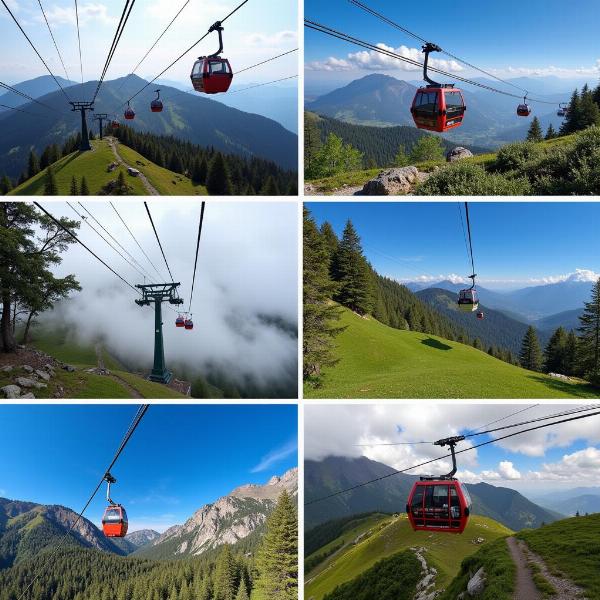Understanding the meaning of “ropeway” in Hindi is more than just a simple translation. It delves into the cultural significance and practical applications of this mode of transport in India. This article explores the various Hindi terms for “ropeway,” their nuances, and the role ropeways play in connecting communities, boosting tourism, and providing efficient transportation solutions. We’ll also look at the technical aspects, cultural impact, and future of ropeways in India.
Understanding the Term “Ropeway” in Hindi
The most common Hindi translation for “ropeway” is “रोपवे” (ropeway), a direct transliteration of the English word. This term is widely understood and used across India. However, other terms like “तार मार्ग” (taar marg), literally meaning “wire path,” or “केबल कार” (cable car) are also used, particularly in specific regions or contexts. While “cable car” often refers to smaller systems, “taar marg” emphasizes the wire-based infrastructure. Knowing these variations can be helpful when discussing ropeways with people from different parts of India.
Ropeways in India: Connecting Communities and Boosting Tourism
Ropeways play a vital role in connecting remote and inaccessible areas, particularly in the mountainous regions of India. They provide a safe and efficient means of transportation for both locals and tourists. Imagine a village nestled high in the Himalayas, previously reachable only by arduous treks. A ropeway transforms access, connecting the community to essential services and opening up opportunities for economic development through tourism.
The Cultural Significance of Ropeways
In many parts of India, ropeways are not just a mode of transport; they are an integral part of the cultural landscape. They offer breathtaking views of the surrounding scenery and have become popular tourist attractions in themselves. Think of the ropeway to Vaishno Devi, a significant pilgrimage site in Jammu and Kashmir. The ropeway not only facilitates easier access for devotees but also offers a unique spiritual experience.
Technical Aspects of Ropeways
Ropeway technology has advanced significantly over the years, leading to safer, more efficient, and environmentally friendly systems. Modern ropeways use sophisticated cable systems, automated controls, and comfortable cabins, ensuring a smooth and enjoyable ride.
Types of Ropeways in India
Different types of ropeways are employed in India, each suited to specific terrains and requirements. These include:
- Aerial Tramways: Used for transporting passengers in enclosed cabins.
- Gondola Lifts: Similar to tramways, but the cabins are often smaller and detachable.
- Chairlifts: Open-air lifts with individual seats or benches.
- Material Ropeways: Designed for transporting goods and materials.
 Different Types of Ropeways in India
Different Types of Ropeways in India
What is the Future of Ropeways in India?
With increasing urbanization and a focus on sustainable transportation solutions, ropeways are poised to play an even greater role in India’s future. They offer a cost-effective and environmentally friendly alternative to traditional modes of transport, particularly in congested urban areas and challenging terrains.
Conclusion
“Ropeway” in Hindi encompasses not just the word “रोपवे” but also its significance as a vital transportation link and a symbol of progress in connecting remote areas and boosting tourism. From the Himalayas to urban landscapes, ropeways are shaping the future of transportation in India.
FAQ
- What is the Hindi word for ropeway? The most common Hindi word for ropeway is “रोपवे” (ropeway).
- Are ropeways safe in India? Modern ropeways in India adhere to strict safety standards and are considered a safe mode of transport.
- Where can I find ropeways in India? Ropeways are found across India, particularly in mountainous regions and increasingly in urban areas.
- What are the benefits of using a ropeway? Ropeways offer scenic views, efficient transport, and are environmentally friendly.
- How much does it cost to ride a ropeway in India? The cost varies depending on the location and length of the ropeway.
- Are there different types of ropeways? Yes, there are various types, including aerial tramways, gondola lifts, and chairlifts.
- What is the future of ropeways in India? Ropeways are expected to play a significant role in future transportation solutions in India.
Related Articles
About Meaning-Hindi.in
Meaning-Hindi.in is your trusted partner for all your Hindi translation needs. We offer a comprehensive range of professional translation services, specializing in business, legal, technical, website localization, educational, and specialized content. Whether you need to translate your business documents, legal contracts, technical manuals, or website content into Hindi, our team of expert translators is here to help. Contact us today for accurate, reliable, and culturally sensitive translations. Email: [email protected], Phone: +91 11-4502-7584. Let Meaning-Hindi.in bridge the language gap for you.